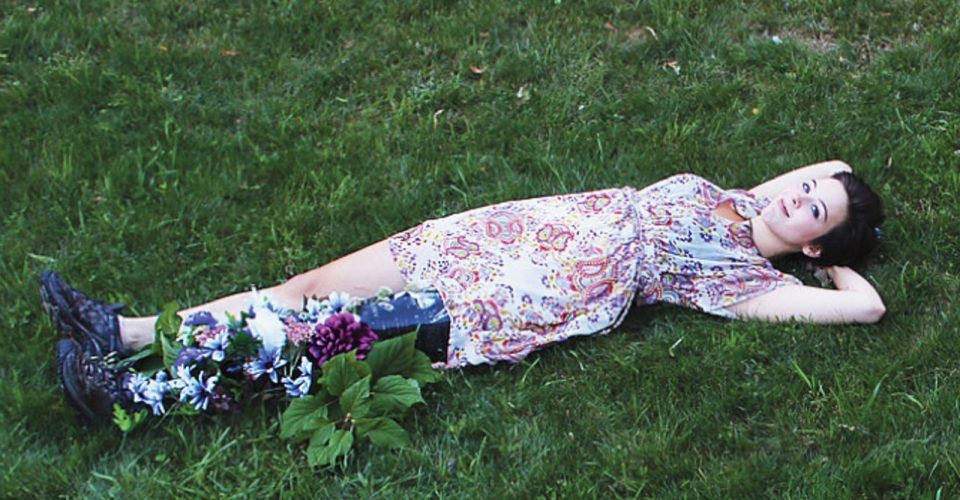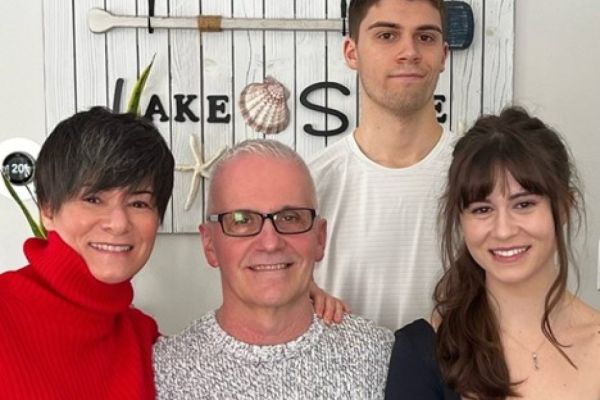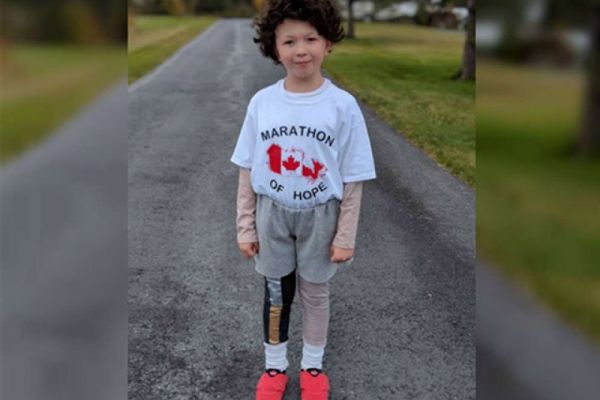A Leg with No Name
Author: Emery Vanderburgh

I’ve never named my prosthesis, which, if you know me, is strange. I named my tumour... “Bowashin”. My residual limb goes by the handle of “Forest Stump”.
and I’ve often personified creatures, objects and other such nonsensical things. Realizing that my prosthetic device wasn’t in my weird crew of characters made me understand the progress I’ve made and how my prosthesis is an integral part of making me feel whole.
Specifically, I think back to when I got my first socket, beige in colour, and how foreign it felt, and how it was just second nature to paint it, to the astonishment of my fellow amputees in rehab. Only after I’d painted it did I truly start including my prosthesis in my identity. Honestly, this helped instill in me the fact that I didn’t need my body to be the way it was before my amputation. I was ready to move on and experiment with a new identity without the baggage of mourning the loss of something that was out of my control. What was cool about this process was that I had to do it all myself; I advocated for what I wanted despite some weird looks. I was still a teenager but I figured out a lot of things on my own.
It isn’t always easy to accept that my prosthetic device is a part of me. Oftentimes, it really feels like it’s working against me, especially when I’m not able to feel comfortable or safe. The initial stages of being fitted with a new limb are, for most people, when a lot of resentment builds up toward the new limb as we go through the endless trial and error of fittings and rehab.
Specifically, I think back to when I got my first socket, beige in colour, and how foreign it felt, and how it was just second nature to paint it, to the astonishment of my fellow amputees in rehab. Only after I’d painted it did I truly start including my prosthesis in my identity. Honestly, this helped instill in me the fact that I didn’t need my body to be the way it was before my amputation. I was ready to move on and experiment with a new identity without the baggage of mourning the loss of something that was out of my control. What was cool about this process was that I had to do it all myself; I advocated for what I wanted despite some weird looks. I was still a teenager but I figured out a lot of things on my own.
It isn’t always easy to accept that my prosthetic device is a part of me. Oftentimes, it really feels like it’s working against me, especially when I’m not able to feel comfortable or safe. The initial stages of being fitted with a new limb are, for most people, when a lot of resentment builds up toward the new limb as we go through the endless trial and error of fittings and rehab.
It isn’t always easy to accept that my prosthetic device is a part of me. Oftentimes, it really feels like it’s working against me, especially when I’m not able to feel comfortable or safe.
For me, the back and forth visits and months in which I could not wear my leg were some of the most difficult challenges I’ve ever encountered. Even so, I still can be nothing but thankful for the functionality my leg has given me.
At its core, having a prosthesis is the difference between using a wheelchair and walking. While I’ve accepted my prosthesis, I also know that acceptance is based partially on the condition of being able to continue to get better with my device in the hope that I will one day get a device that will be much more intuitive to my needs and save my sound limb from undue wear and tear.
Of course, the better the technology the easier it is to view a prosthesis as a part of you. Better technology provides amputees with better quality of life, not only on a physical and functional level, but psychologically as well. I cannot say it enough: no one should feel like they are being held back by their prosthetic limb or limbs, because they are as much a part of us as any other facet of our body. Coming to that realization was so beneficial for me.
I’ve had my leg for almost three years and it’s really only now that I have integrated it into my daily life. Part of this is figuring out what I can and cannot do, along with all the little tricks I’m learning along the way. For example, silly things like the fact that I put my shoes on backwards and I cut my tights and tie them in bows. I’ve learned to adjust and adapt and all in all, they’re things that seem natural to do now but had been uncomfortable to do when my prosthesis still felt foreign to me.
So here we are. I’ve named my stump, but will never name the device that I put it into every morning. After my amputation, Forrest Stump felt like a new resident on my body. He is the reason I can wear my leg and emblematic of what I’ve survived. I love my little nubby dearly; however, the thing I don each morning and remove each night is simply my prosthesis – the thing I use to move and express myself. Sometimes it is cumbersome. I don’t use it for every activity. But the more I learn about this new part of my body, the more it feels like it’s me, and well... I already have a name.
At its core, having a prosthesis is the difference between using a wheelchair and walking. While I’ve accepted my prosthesis, I also know that acceptance is based partially on the condition of being able to continue to get better with my device in the hope that I will one day get a device that will be much more intuitive to my needs and save my sound limb from undue wear and tear.
Of course, the better the technology the easier it is to view a prosthesis as a part of you. Better technology provides amputees with better quality of life, not only on a physical and functional level, but psychologically as well. I cannot say it enough: no one should feel like they are being held back by their prosthetic limb or limbs, because they are as much a part of us as any other facet of our body. Coming to that realization was so beneficial for me.
I’ve had my leg for almost three years and it’s really only now that I have integrated it into my daily life. Part of this is figuring out what I can and cannot do, along with all the little tricks I’m learning along the way. For example, silly things like the fact that I put my shoes on backwards and I cut my tights and tie them in bows. I’ve learned to adjust and adapt and all in all, they’re things that seem natural to do now but had been uncomfortable to do when my prosthesis still felt foreign to me.
So here we are. I’ve named my stump, but will never name the device that I put it into every morning. After my amputation, Forrest Stump felt like a new resident on my body. He is the reason I can wear my leg and emblematic of what I’ve survived. I love my little nubby dearly; however, the thing I don each morning and remove each night is simply my prosthesis – the thing I use to move and express myself. Sometimes it is cumbersome. I don’t use it for every activity. But the more I learn about this new part of my body, the more it feels like it’s me, and well... I already have a name.
WHAT’S YOUR STORY?
Living with amputation is a very individual thing – particularly when it comes to coping, adapting, accepting and finding humour in our missteps. Emery’s approach to limb loss is just that… her way. Hopefully there is a nugget or two in her story that you can relate to, or borrow. We here at thrive would love to hear your story, and share it with other amputees.
What’s your story? E-mail us atThis email address is being protected from spambots. You need JavaScript enabled to view it. .
What’s your story? E-mail us at










 How to resolve AdBlock issue?
How to resolve AdBlock issue?